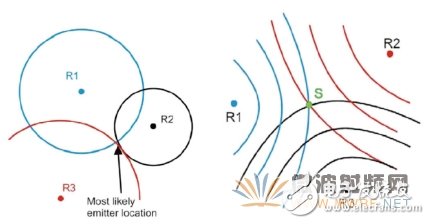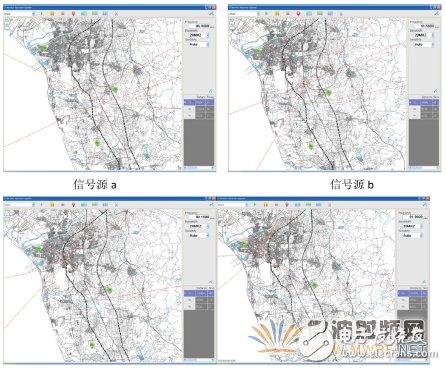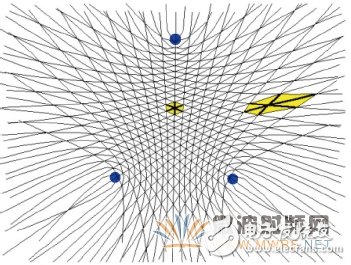Abstract: This paper introduces the basic principles of TDOA (TIme difference of Arrival), enumerates the advantages of TDOA positioning, and analyzes its effectiveness in practical applications through examples. Combined with experimental data, it analyzes the factors affecting TDOA. This paper proposes that TDOA is a simple and efficient positioning method that can be widely used in radio monitoring work.
1. Introduction to TDOAThe location of the interference source is one of the important contents of the radio spectrum management. The main positioning methods include two categories: composite angle positioning method and time difference positioning method. The composite angular positioning method is based on radio direction finding, and the same signal is measured by a plurality of radio monitoring stations, and the intersection of the direction finding rays (angles) is used for positioning. The time difference positioning rule is based on the time when the signal arrives at the monitoring station, and the time distance is converted to perform the intersection positioning.
TDOA is a method of positioning with time difference. By measuring the time that the signal arrives at the monitoring station, the distance of the signal source can be determined. The position of the signal can be determined by using the distance from the signal source to multiple radio monitoring stations (centered at the radio monitoring station and the radius is rounded). By comparing the time difference between the signals arriving at multiple monitoring stations, a hyperbola with the monitoring station as the focus and the distance difference as the long axis can be made. The intersection of the hyperbola is the position of the signal (see Figure 1, Figure 2).

Figure 1 TDOA positioning diagram Figure 2 Hyperbolic intersection positioning diagram
TDOA is a multi-site based positioning system, so at least 3 monitoring stations must be simultaneously measured to locate the signal. The composition of each monitoring station is relatively simple, mainly including the receiver, antenna and time synchronization module. In theory, existing monitoring stations can be upgraded to TDOA monitoring stations as long as they have time synchronization modules, without the need for complicated technical modifications.
2, the advantages of TDOACompared to the composite angle positioning method, TDOA has the following advantages:
(1) TDOA does not have the problem of phase ambiguity, so the homing baseline can be unrestricted. The traditional direction finding method needs to calculate the azimuth by phase, and the phase measurement has the uncertainty of 2Ï€ period. Therefore, the method that the antenna baseline is smaller than the signal wavelength is often used to avoid the 2Ï€ cycle rewind. However, the wavelength of the high-frequency signal is short, so that the distance of the test antenna is relatively close, and signal coupling is easily generated, so that the measurement produces an error. And each TDOA monitoring station only needs one antenna, which fundamentally solves the problem of signal coupling.
(2) TDOA system has low complexity. For TDOA monitoring stations, only the monitoring antenna and receiver need to be configured, and the requirements for the antenna are not high, even if different monitoring points use different antennas. The direction finding antenna itself is an antenna array composed of a group of antennas, and the performance of each antenna in the array is as consistent as possible, otherwise the accuracy of the direction finding is affected, thereby making the system cost high, which is not conducive to extensive monitoring. .
(3) The accuracy of TDOA system positioning is high. For TDOA inspection stations, the positioning accuracy depends on the accuracy of the time measurement. With the optimized algorithm, the calculation error of the time difference is on the order of 100 ns, which is about 30 m from the accuracy of the positioning. The error of the Class A direction finding station is generally 1 degree. For the signal error of 5m, the signal error is 87m, and the signal error of 10km is 174m.
3. The actual case of TDOAThis paper selects the receiver products based on the NI PXI platform as the main equipment of the TDOA experiment, including the broadband receiver module, GPS clock module and high-speed data processing module. The NI PXI wideband digital receiver has a maximum bandwidth of 50MHz, which can meet the high-speed digital signal receiving requirements. At the same time, the noise floor is only 9dB. It has strong monitoring ability for weak signals and also makes the coverage radius of monitoring larger. The highly sensitive GPS module can track 12 GPS satellites at the same time, ensuring the measurement accuracy of time difference. The signal processing and calculation module uses NI (National Instruments)'s latest embedded controller, which uses the i7 processor to provide powerful processing power for multi-station signal correlation calculations. At the same time, in addition to providing high-speed digital transmission, the open PXIe system bus also guarantees the accuracy of time measurement with a short trigger delay.
In addition, the flexibility of the system is reflected in the antenna selection of TDOA. The monitoring station selected for the experiment included a new fixed station (Site A), a monitoring station (Site B) built 10 years ago, and a moving monitoring station (Site C). The antenna used at Site A is a high-sensitivity monitoring antenna with a sensitivity of 0.1μV/m. The original monitoring antenna multiplexed by the station B realizes time-sharing multiplexing of different devices through switch switching. Site C uses a moving antenna with a small antenna size.
Since Site A and Site B are fixed stations, the site erection process has been completed in advance. When setting up the C station, you only need to connect the signal antenna and GPS antenna to the receiver and expand the antenna. The whole process needs only one technician to complete.
In this paper, the A site is selected as the central station, and the information of the B station and the C station is summarized for calculation. The data exchange between the monitoring stations uses the original IQ signal. After being aggregated to the A station, the data can be further recorded for later verification and research. The entire data transmission uses a 3G network and compression algorithm. In the experiment, the system responded promptly and reliably.
In terms of the calculation of the time difference, a signal correlation algorithm is currently used. In the course of this experiment, the correlation algorithm has high precision, and there is no special requirement for the signal to be measured, which is a relatively common signal algorithm. The data recorded in the record can be used as an evidence record of the interference check, and the playback state of the interference source is displayed by the playback data. At the same time, these data can also be used for future examples of algorithm research and interference investigation.
In the course of the experiment, in order to test the performance of TDOA, this paper selected four different sources to measure. Table 1 shows the relative position between the signal source and the monitoring station. Table 2 shows the difference in arrival time of the actual test signal.
Table 1 Relative position between signal source and monitoring station (unit: meter)

Table 2 The difference in arrival time of the actual test signal (unit: μs)

By scaling, the distance difference between the signal source and the different monitoring stations is obtained, and the difference is marked on the map by hyperbola, and the test result can be obtained (see Fig. 3).

Figure 3 Results of the experimental test
Table 3 shows the error between the test result and the actual station distance.
Table 3 Error between test results and actual station distance (unit: meter)

The test results show that the minimum positioning error is 18 meters and the maximum positioning error is 220 meters, which matches and exceeds the positioning level of the A-level direction finding station, indicating that TDOA is a very effective positioning method.
4, TDOA test results discussionFurther analysis of the test results of the signal sources at different locations shows that the accuracy of the positioning is highest when the signal source falls inside the triangle formed by the monitoring station. The more the position of the triangle edge, the larger the error. This can be explained by the hyperbolic curvature change. In Figure 4, the blue point is the position of the monitoring station, and the hyperbola forms the coordinate grid at equal intervals. The yellow area consists of adjacent hyperbolic curves. For the triangular edge area, the larger the area enclosed by the same mesh, the larger the measurement error. The solution to this problem is to add more monitoring stations and select the most suitable 3 stations for initial positioning. This can improve the accuracy of signal positioning.
In addition, for the characteristics of TDOA positioning method, the accuracy of time measurement is very important, and the main factors affecting measurement include GPS timing accuracy and signal sampling error. In this case, high-performance GPS is used, and its nominal error is only 15 ns. However, considering the GPS signal error of multiple stations, the GPS jitter of the two monitoring stations is less than 20 ns in actual measurement, which does not affect the overall index of the system.

Figure 4 TDOA hyperbolic diagram
The sampling rate provides the minimum time unit for signal analysis. If the sampling rate is too low, the time resolution is not high enough, which affects the measurement accuracy of the system. The high-speed digitizer used in this experiment has a maximum sampling rate of 150 Mb/s and a time resolution of 6.7 ns, which can fully meet the system requirements.
5, TDOA positioning summaryIn summary, TDOA positioning is a stable and reliable network-based positioning method. National Instruments' spectrum monitoring receiver based on modular instrumentation system can provide high-performance receiver module with high bandwidth and low noise floor and high-accuracy clock module, which is ideal for implementing TDOA positioning system. platform. The modular structure maximizes the use of existing test equipment resources and is suitable for the positioning and detection of new radio signals.
160W Medical Power Supply,160W Medical Device Power Supply,160W Medical Power Adapter,160W Rade Power Supplies
Shenzhen Longxc Power Supply Co., Ltd , https://www.longxcpower.com